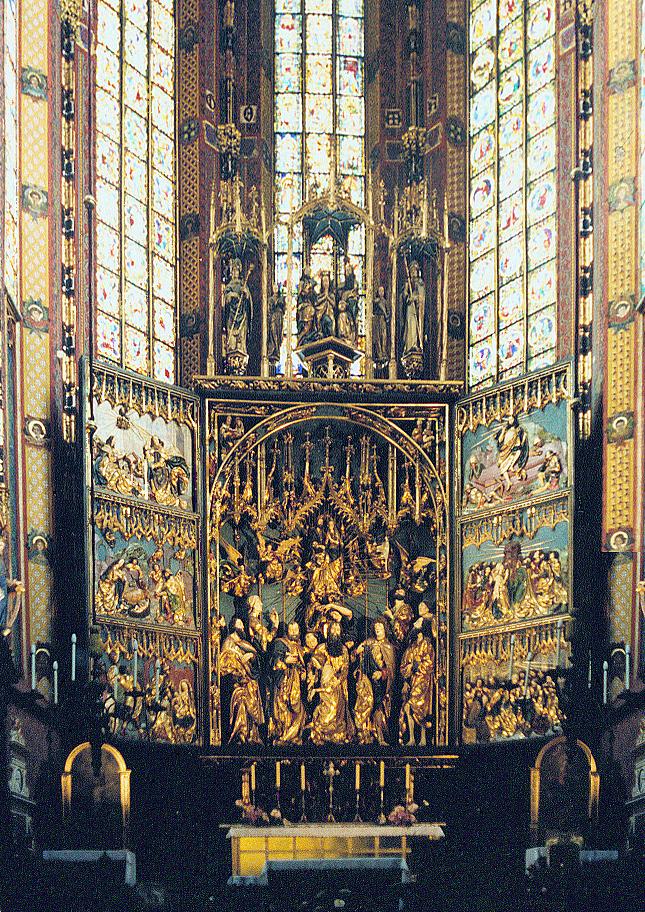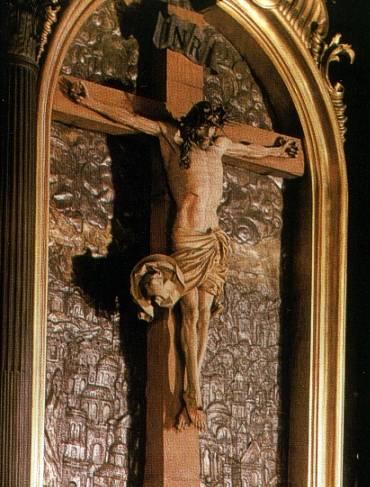
Reserved Area
Artists - ArtWorks
Wit Stwosz
 Poland
PolandThe Gothic Sculpture and Architecture
Wit Stwosz :
The Altar in St. Mary’s Church in Cracow (The St. Mary’s Altar)
Wit Stwosz lived and created in the turn of XV and XVI centuries. It is not quite sure when he was born: in 1443, 1447 or 1448, and his life lasted for about 90 years (he died in 1533). His great masterpieces include sculptures made in German, where he was born and where he spent his initial 30 years, next he moved to Cracow, where he came to make the altar (actually he spent 19 very laborious years in Cracow).Later he again lived in Germany in Nuremberg, where he spent his last 40 years of life, starting from the ending period of the XV century. Stwosz’s art is included within the area of historians’ considerations to the late gothic. .
The altar made especially for the St. Mary’s Church in Cracow is beyond all doubts the most magnificent masterpiece of the artist and it was being created in the period of years: 1477- 1489. During his stay in Cracow, Stwosz made also other interesting sculptures.
The XIII and XIV century was including a very intensive development of the cities. The dominating trend of art was gothic. Besides the buildings featuring a religious character (cathedrals, churches, chapels, monasteries), there tended to appear buildings just typical of secular destination- town halls, the chambers of public meetings, square buildings (like Sukiennice in Cracow), gothic houses. There also widely functioned craftsmen’s places- workshops completing the cities’ needs and the aspirations of the Church notables and secular eminent persons. The architecture was still a domain of monasteries’ masters, however there were also known secular builders. A similar situation was with the creators of sculptures and paintings, and with the illuminators of writing art. The specialists while working in workshops formed together craftsmen’s guilds. Their fame was sometimes very observable, even in remote places.
The City of Cracow was then developing very much. It was the Royal Capital of the State and the place of a very important university level school. The city- dwellers got more and more rich and they started appearing to be a community putting forward numerous orders aspiring towards ambitious masterpieces. The initiative of the Council of the City of Cracow started off a historic event of the main altar’s constructing in the St. Mary’s Church in Cracow. The Council’s resolution was the engagement of Wit Stwosz as regards the responsibility for that purpose (he also signified himself as Veit Stoss, Stvos). In Cracow, like in other Polish cities there were functioning (as e.g. in Wroclaw) prosperous workshops, in which there were created sculptures dedicated to the sacral themes, including the altars to numerous churches. Those altars were mostly big constructions, usually wooden wardrobes, 3 parts combined constructions or multi structures made in wood and often finished off in golden polychromic. Wit Stwosz was largely appreciated in public. He was treated like a countryman after many years of working together with local residents. His biggest masterpiece appeared just in Cracow, just there he had his 13 children, most of those made an artistic career. His son Marcin decided to live there permanently, and his domain was craft in gold. The Polish society seems to be still very attached to the altar’s creator, and without any hesitation around them, he is called just a Polish sculptor.
The last phase of gothic corresponding to the XIV and XV century was called the international style in Europe. There appeared then an observable uniformity as regards a participation of various social levels in the course of founding the gothic masterpieces and their creative reception. The result of that tendency was the common artistic language in the whole Europe, and also in Poland. The craftsmen’s’ workshops (an artist was then called barely a craftsman) followed the fame of more famous guilds (e.g. in Wroclaw). The churches of all the cities were fulfilled with sculptures presenting beautiful Madonnas, holly persons, scenes of Christ’s Crucifixion or the Final Judgment’s Day.
The Altar in St. Mary’s Church, whose theme is Mary’s Falling Asleep, initiated a thematic repetition in other Polish cities. That happened in Swidnica (1492), in Wroclaw (1492), in Borki Wielkie, close to Olesno (in 1500). In keeping with Stwosz’s appearance, Cracow started to be a sculpture art’s centre in the scale of Poland.
The sculptors started to be recognized and sometimes known after their names, e.g. coming from Silesia- Jost Tauchen, Jakub Beinhart, or the Master of Lubin’s Figures; coming from Gdansk- e.g. Hans Brandt.
In Poland, Wit Stwosz was the greatest person of his profession, although he was not the only representative of the ending phase of gothic. In Gdańsk,an important figure was Hans Brandt, a creator of the St. Adalbert’s Grave in Gniezno (1479-1499), in which he combined monumentality with expression and Verism. In that time there took place also a development of painters’ workshops, in which there were produced competitive painted altars. A contemporary creator was also a famous representative of the Wroclaw Workshop, a creator of the St. Barbara’s Altar, but that one was a painting composition. Whereas Taking everything into consideration, the Stwosz’s Altar in Cracow had not an equal counterpart in the scale of Poland of that epoch. Unfortunately, any other object of that kind could hardly make efforts so as to approach his level of masterpiece, and the Stwosz’s Altar was still an unattainable pattern for its imitators.
His Altar was exceptional as regards the question of dynamism, a whole composition of iconography record, and in a wit of elaborating details.
There were imitated dynamically composed clothes, and the scenes were zealously copied. There were carved other altars: in Ksiaznice Wielkie, in Zywiec, in the Jan Olbracht’s Chapel in Wawel, and the altar representing St. Stanislaw in the St. Mary’s Church.
Still existing famous Silesian workshops continued servicing large orders referring to altars’ installment, but very hardly could make efforts to approach the level of the masterpiece from Cracow.
The Altar is a pentaptic ( it has double wings: one pair is stationary, while the second is shutting the wardrobe). The sizes are: 11 metres of width and 13 metres of height. It consists of pradella (2 metres), the middle wardrobe (7.25x 5.35 metres), the wings mentioned and the remarkable ending up in the top. The material is oak wood ( for construing the figures) and lime wood.
The scene In the main wardrobe- the Middle one-is St. Mary’s Falling Asleep. Mary is accompanied by the Apostles. Just over that scene, the artist carved the scene of Mary’s Taking to Heaven and Her Meeting with Jesus. Over the whole middle scene, there dominates the scene of Mary’s Coronation.
The noticeable half- spherical framing of the wardrobe entails the figures of the prophets. The Altar’s wings are divided into the quarters. While the wings are open, they present the 6 quarters of the scenes dedicated to St. Mary’s Joy, whereas they are shut, they introduce the effect of the presence of the 12 quarters (that means; together with the quarters found on the permanent wings) presenting the scenes of Jesus and his Mother’s Life. The whole of that big challenge is to the utmost extraordinary: the characters of the main scene are purposely bigger than real life person (almost 3 metres of height). They construe an expressive wave of shapes and colours fulfilling decoratively the scene, and simultaneously remaining under the adjusted rule of the regular box for- typical of the so- called Mariology Theme in Art. It is encountered here both naturalism of manners and the detailed illustration of the anatomic parts of the human characters.
It is also demonstrated a symptom of a courtly presentation (e.g. in the part of St. Mary’s fainting hands), and even a great artistic care for elaboration of the clothes, coats’ creases, etc. The very detailed illustration of vegetation, objects and the indicated familiarity with illnesses prove a very precise world’s observation made by the artist and his necessary versatile knowledge. An attention can be drawn by a vivid presentation of the earthly picture of those times’ city- dwellers- nota bene the donators of the whole enterprise.
Beyond all doubts, Wit Stwosz came to Cracow possessing wide knowledge abort the corresponding works’ trends among the artists from the Netherlands and Germany. He is presumed to have known the works of a sculptor Nicholas from Leida, a painter Roger van der Weyden, a graphic- Master E.S. and Martin Schongauer. That remains enough to say about the best art’s influence on the Master Stwosz.
Elaborating on the Altar’s composition lasted for 10 years. Wit Stwosz was remaining In Cracow for nearly 20 years. He was also responsible for other order’s execution. Among his masterpieces coming from his staying In Cracow, it is worth mentioning: Crucifix ( In the St. Mary’s Church in Cracow, too), a bas- relief “Christ in the Garden”, the grave of the King Kazimierz Jagiellonczyk (the Wawel Cathedral), the grave of the Bishop Piotr from Bnin (the Cathedral in Wloclawek), the grave of the Primate Stanislaw Olesnicki (remarkably built in the floor of the Cathedral in Gniezno).
The Altar of St. Mary’s Falling Asleep is an exceptional masterpiece. Within the Polish art, we cannot find any other one so spectacular in correspondence to such a category, taking into consideration its vividness, supernaturalism, elaboration in every detail and the glorification’s aspect. In that epoch, its fame was crossing the State’s borders. It fully confidences a great talent of the artist, but what is more it reflects a great generosity of the Cracow’s city- dwellers- an important social class leveled up in the ending phase of the Middle Ages.
The author of that great enterprise came to Poland from Germany, but just in Cracow he dedicated to that masterpiece his 10 years, and the selected one is famous as the fundamental masterpiece of his life.
Cracow and Poland accepts Wit Stwosz as his own master in carving, although in fact he came to Cracow from Swabia.
Author: T. Dobrowolski, Title: ”Wit Stwosz. Ołtarz Mariacki” (”Wit Stwosz: The St Mary’s Altar”), Publication: Cracow,1985
Author: Tadeusz Chrzanowski, Title: ”Ołtarz Mariacki Wita Stwosza” (”The Wit Stwosz’s St Mary’s Altar”), Publication: “Interpress” Edition
Author : P. Skubiszewski, Title: ”Wit Stwosz” (“Wit Stwosz”), Publication: Warsaw, 1985
Author: A collective work, Title: ”Sztuka Świata” (”The World’s Art”),Lexicon L-Z, vol. 13, Publication: Warsaw, 2000
http://www.bryk.pl/teksty/liceum/j%C4%99zyk_polski/biografie/2834-wit_stwosz_biografia.html
http://www.tarnowskie.koscioly.sl.pl/biogramy/s/stwosz.htm
http://pl.wikipedia.org/wiki/O%C5%82tarz_Wita_Stwosza_w_Krakowie
Related Material:
Image available

File name: 39_Krakow_oltarz_Stwosza.jpg
Description of the material:
The source says about the overall vision of the Wit Stwosz's altar, the plots and the reality constituting its contents, its rebirth among the local dwellers' society.
Contextualisation Of the source:
The context is to display the connections between the artistic individual workshop from abroad and its fulfilling itself in producing adapted glorious themes lively existing within the local level of the town as regards the vivid, allegorical and spacial ideas. http://upload.wikimedia.org/wikipedia/commons/0/02/Krakow_oltarz_Stwosza.jpg
Interpretation of the source:
The source speaks in a loud voice about all the values of the artefact, its splendour, memorable recognition, its permanent position and remarkable grade in our history and heritage.

File name: 39_wit2.jpg
Description of the material:
The source says about the collections of sacral artefacts, present in churches in the evidenced city.
Contextualisation Of the source:
The context is to evidence the sacral figures, and objects of church dedication- demonstrated in splendour and elaborated ornaments at the level of structure and scenery. http://www.tarnowskie.koscioly.sl.pl/biogramy/s/wit2.jpg
Interpretation of the source:
The source can be interpretated as the basis of observations in the frames of the sacral sculptures' and iconography's beauty, pathos and vividness.
Comments about this Artist/ArtWork
Date: 2009.05.28
Posted by Simone Lechner-Erbach, Landau, Germany
Message: thank you very much for this useful analysis
;)
Michelangelo - Copyright 2008 - This project has been funded with support from the European Commission